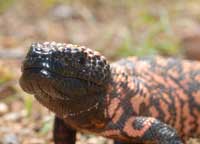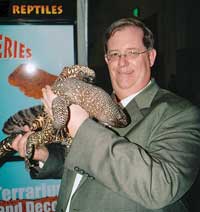Two venomous lizards that are fascinating creatures are Gila monsters and beaded lizards.
Awhile back, I wrote a blog about the movie The Giant Gila Monster. The movie is a pretty boring entry into the cheesy B-movie monster pics of the 1950s, and it didn’t go very far in promoting much good will toward Gila monsters. As a matter of fact, it was a bit of a frame job for them, because the lizard used in the movie was actually a beaded lizard, spending most of the movie crawling around, occasionally knocking around some model buildings and cars. Too bad the movie wasn’t in color and didn’t use an actual Gila monster. Then it might have been at least a bit more interesting to watch due to the beautiful coloration of a Gila monster. Nothing against beaded lizards – they’re cool, too – but Gila’s are more colorful. Alas, the movie was ultra low budget and filmed in black and white, so viewers were treated to a pretty dark, mostly black-mottled-with-gray lizard crawling around the toy cars.
The Gila monster (Heloderma suspectum) and Mexican beaded lizard (H. horridum) are the two most famously venomous lizards in the world. For many years they were thought to be the only two venomous lizards, but research indicates that other species, including some monitor species such as the Komodo monitor, reportedly produce venom. I’ve never been bitten by a Gila monster or a beaded lizard, and I hope I never am. Someone once told me being bitten by a Gila monster was comparable to having your hand slammed in a car door and burned at the same time. Not a pleasant thought! They have very strong jaws that can latch onto their prey. The bite is painful enough, I’m sure, but next comes the grinding. The teeth of a Gila monster, though sharp, are not hollow and used like hypodermic needles the way venomous snakes’ fangs are. The way Gilas envenomate is by grinding their jaws together while biting, while at the same time venom is released from glands in the lower jaw to flow through grooves in the teeth into the wound they’re chewing. Sounds pretty nasty, doesn’t it? Their venom is fairly mild and humans are not known to die from it, but their bite sounds like it hurts like a son of a gun.
The name “Gila monster,” and the resulting capitalization, is due to the fact that the lizard’s southwestern U.S. habitat includes the Gila River Basin in Arizona, where it was first discovered. Less certain is who originated the “monster” portion of the common name, but due to the lizard’s heavy, stumpy body, tenacious bite and lumbering movement, it’s not difficult to imagine why it was used. The scales are beadlike (just like its cousin the beaded lizard, and hence its cousin’s common name), black and usually a shade of either orange, yellow or pink. Gila monsters really are very beautiful lizards, and their patterns are like snowflakes in that no two are exactly alike. The beaded lizard closely resembles the Gila monster, though it exhibits more black coloration and gets larger than the Gila. Gilas generally average around 18 inches in length, and beaded lizards can get up to about 3 feet. The beaded lizard also inhabits habitat in Mexico rather than the U.S. (though the Gila’s range can extend into northern Sinaloa in Mexico).
I’ve never seen either heloderm in the wild. I did get to hold a nice big beaded lizard that belonged to Bob Applegate, though. Bob is well-known for working with kingsnakes and milk snakes, as well as breeding beaded lizards. I was at a trade show once, I think it was around 2006, and Bob was there. He had some beaded lizards and Gilas with him, and he let me hold his biggest beaded lizard. That was very cool. I ran the photo of me holding the beaded, with a smaller Gila on top of it, as my editor’s picture in REPTILES magazine for awhile (and it’s included with this blog). I remember photographer and author Karl Switak gave me a hard time, accusing me of acting cavalierly by holding these venomous lizards without any kind of safety precautions, including gloves. I guess it was a bit reckless for me to do so, but the lizards were pets of Bob’s and very docile, and he assured me it was safe. That said, although I was “star struck” and held two venomous lizards without using gloves, I would not suggest that anyone else do so, especially not beginners.
Gilas and beaded lizards primarily inhabit dry, scrubby habitat, though they may be found in woodsy areas, too. It’s easy to tell by looking at them that they’re not the fastest, most agile lizards in the world. Because they’re somewhat gawky and would not be able to snag fast-moving animals, they eat easy-to-catch prey, such as baby birds and rodents, as well as bird eggs. That’s not to say that they never eat anything else; they do, including lizards, mammals, frogs and carrion.
Interesting folklore surrounds the Gila monster, and you can read about it the book, Gila Monster: Facts and Folklore of America’s Aztec Lizard. A 1900 newspaper clipping written by someone named H.G. Tinley is reprinted in the book, talking about the relationship between the Gila monster and some Native American cultures. It reads:
“The Pima, Apache, Maricopah and Yuma Indians of the Southwest, who have little fear of the bite of a Mexican centipede or a rattlesnake, will hunt a Gila monster cautiously to its death, and even go many miles to rid the country of one of these reptiles, which they regard as the most to be dreaded of anything that crawls. Among the Cocopahs of Lower California the tribal belief is that the most fearful vengeance that may come to the spirit bodies of bad Indians after this life, is to be bitten by a red Gila monster that roams, unseen by mortal eyes, over the adobe plains waiting to snap at the red-skinned savages inimical to the great spirit chief.”
The book also quotes a tale from the 1920s, collected by novelist Harold Bell Wright, that offers an explanation of the Gila monster’s attractive coloration. Centuries ago, the tale goes, the first saguaro wine festival was held, and all the Native American tribes were invited, as well as all the animals. Everyone wanted to look their best for the feast, and the Gila monster gathered bright pebbles in order to make a beautiful coat that he continues to wear to this day.
I think this latter tale represents the Gila monster in a better way than The Giant Gila Monster. But no matter what your opinion of these two very intriguing lizards, the Gila monster and the beaded lizard are unlike any other reptilian denizen in the animal world. For that, they command respect.





